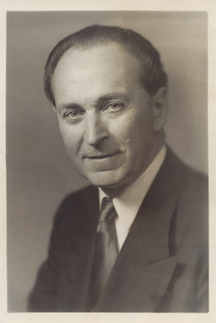Gerrit de Jong Jr.: Mormon Scholar
Gerrit de Jong Jr. was an educator, administrator, musician, artist, and linguist. He was the first dean of the College of Fine Arts at Brigham Young University, and he is also credited for its founding. He also spent much of his career teaching foreign languages and taught piano, organ, phonetics, aesthetics, and religion. The de Jong Concert Hall at BYU is named in his honor. He composed music in all forms; some of his compositions were performed by the Paganini String Quartet throughout the 1940s.
De Jong was born on March 28, 1892, in Amsterdam, Holland. He studied drawing as a youth and his work was exhibited in Vienna and other European cultural centers. His grandfather took him to Rijksmuseum to study the great masters.
In 1906, when his father’s business burned down, he immigrated to Salt Lake City with his parents and sister to live with an aunt who had immigrated a few years earlier. He was fourteen years old at the time. He and his family converted to The Church of Jesus Christ of Latter-day Saints. He earned a bachelor’s degree in Spanish and a master’s degree in French from the University of Utah, and a PhD in German with a minor in romantic languages from Stanford University. He later researched in the Bavarian University in Munich. He was fluent in English and Portuguese and also learned Chinese. In 1947, the US State Department asked him to direct its cultural center in Santos, Brazil, where he served for the academic year 1947–1948. To many, he was known as Mr. Portuguese for his accomplishments and contributions with the language and literature. His skills also prompted Church officials to ask him to translate the temple ceremony into Portuguese—a task he considered the most important teaching of his life. He lectured and wrote in six languages for the Church of Jesus Christ and international governments.
"In 1925, looking for someone to establish the new College of Fine Arts at BYU, President Franklin S. Harris approached de Jong, who gladly accepted and became dean (for 34 years) of the first college of its kind in the western United States. By the end of his life, the college included 2,500 students and offered courses in all the major art programs as well as in speech and communications. Aside from his responsibilities as dean, he taught piano, organ, aesthetics, phonetics, and religion."[1] He was honored in 1959 with the second Karl G. Maeser Distinguished Teaching Award.
He served as a member of the general board of the Deseret Sunday School Union, the general board of Religion Classes, and the general Church Music Committee.
De Jong was an accomplished musician. He played piano for Salt Lake City silent movies. He studied organ under Tracy Y. Cannon, Mormon Tabernacle organist. He also sang in the Mormon Tabernacle Choir, directed a 42-piece orchestra, and led a men’s chorus. He is the author of the Latter-day Saint hymn "Come, Sing to the Lord" (#10) included in the 1985 Hymns of The Church of Jesus Christ of Latter-day Saints. de Jong researcher and writer Charlene Winters related this story of him:
- As a teenager living in Salt Lake City, he was asked to play the organ for a special priesthood meeting. When he asked for a key to the church so he could practice, the bishop dismissed the idea, insisting that with his talent he didn’t need to practice. Undeterred, de Jong went to the church and, upon finding the doors and windows locked, went down an opening in the coal chute. After brushing himself off, he took his music and practiced until he felt he had mastered the composition. After the performance, several people praised de Jong, including the bishop, who told the young musician he knew he had not needed to practice.[2]
Prior to his career at BYU, de Jong taught school in Salt Lake City and Beaver, Utah.
He and his first wife, Rosabelle Winegar, were the parents of four children: William Gerrit who died at thirteen months, Belle, Nola, and Carma. Rosabelle died tragically in 1940 and he married Thelma Bonham in 1951. He died on September 26, 1978, in Provo, Utah. In 2015, he was honored as one of the founders of the college at the 50th anniversary of the Harris Fine Arts Center.
